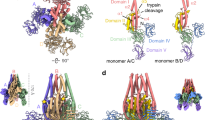Abstract
Bacillus thuringiensis vegetative insecticidal proteins (VIPs) are not homologous to other known Cry proteins, and they act against lepidopteran larvae via a unique process. All reported studies on the mode of action of Vip3 proteins have been performed on the Vip3A family, mostly on the Vip3Aa subfamily. Vip3Aa proteins are activated by midgut proteases, and they cross the peritrophic membrane and bind specific proteins in apical membrane epithelial midgut cells, which results in pore formation and, eventually, death to the insects. Some studies of trypsin-activated protein (core fragment) and the full-length protein show differences in mortality on the same insect species. The N-terminus of Vip3A proteins is responsible for the translocation of the protein across the cell membrane. To determine whether the N-terminus of Vip3Aa11 proteins contribute to insecticidal activity, we exchanged Vip3Aa11 residues with Vip3Aa39 no-core fragment residues using site-directed mutagenesis. Bioassays showed that the toxicity of S9N, S193T, and S194L mutants displayed approximately one- and twofold increases in toxicity against Helicoverpa armigera. Mutant protein R115H demonstrated a threefold decrease in toxicity. This work serves as a guideline for the study of the Vip3Aa11 no-core fragment protein insecticidal mechanism.


Similar content being viewed by others

References
Sanahuja G, Banakar R, Twyman RM, Capell T, Christou P (2011) Bacillus thuringiensis: a century of research, development and commercial applications. Plant Biotechnol J 9(3):283–300
Chakroun M, Banyuls N, Bel Y, Escriche B, Ferré J (2016) Bacterial vegetative insecticidal proteins (Vip) from entomopathogenic bacteria. Microbiol Mol Biol Rev 80(2):329–350
Estruch JJ, Warren GW, Mullins MA, Nye GJ, Craig JA, Koziel MG (1996) Vip3A, a novel Bacillus thuringiensis vegetative insecticidal protein with a wide spectrum of activities against lepidopteran insects. Proc Natl Acad Sci USA 93(11):5389–5394
Sauka DH, Rodriguez SE, Benintende GB (2012) New variants of lepidoptericidal toxin genes encoding Bacillus thuringiensis Vip3Aa proteins. J Mol Microbiol Biotechnol 22(6):373–380
Bergamasco VB, Mendes DR, Fernandes OA, Desidério JA, Lemos MV (2013) Bacillus thuringiensis Cry1Ia10 and Vip3Aa protein interactions and their toxicity in Spodoptera spp. (Lepidoptera). J Invertebr Pathol 112(2):152–158
Crickmore N, Baum J, Bravo A, Lereclus D, Narva K, Sampson K, Schnepf E, Sun M, Zeigler DR. (2016). Bacillus thuringiensis toxin nomenclature. http://www.btnomenclature.info/. Accessed 1st December 2016
Wu J, Zhao F, Bai J, Deng G, Qin S, Bao Q (2007) Evidence for positive Darwinian selection of vip gene in Bacillus thuringiensis. J Genet Genomics 34(7):649–660
Liu J, Song F, Zhang J, Liu R, He K, Tan J, Huang D (2007) Identification of vip3A-type genes from Bacillus thuringiensis strains and characterization of a novel vip3A-type gene. Lett Appl Microbiol 45(4):432–438
Abdelkefi-Mesrati L, Boukedi H, Dammak-Karray M, SellamiBoudawara T, Jaoua S, Tounsi S (2011) Study of the Bacillus thuringiensis Vip3Aa16 histopathological effects and determination of its putative binding proteins in the midgut of Spodoptera littoralis. J Invertebr Pathol 106(2):250–254
Lee MK, Walters FS, Hart H, Palekar N, Chen JS (2003) The mode of action of the Bacillus thuringiensis vegetative insecticidal protein Vip3A differs from that of Cry1Ab delta-endotoxin. Appl Environ Microbiol 69(8):4648–4657
Ben Hamadou-Charfi D, Boukedi H, Abdelkefi-Mesrati L, Tounsi S, Jaoua S (2013) Agrotis segetum midgut putative receptor of Bacillus thuringiensis vegetative insecticidal protein Vip3Aa16 differs from that of Cry1Ac toxin. J Invertebr Pathol 114(2):139–143
Estruch JJ, Yu CG (2001) Plant pest control. US Patent 6,291,156 B1
Yu X, Liu T, Sun Z, Guan P, Zhu J, Wang S, Li S, Deng Q, Wang L, Zheng A, Li P (2012) Co-expression and synergism analysis of Vip3Aa29 and Cyt2Aa3 insecticidal proteins from Bacillus thuringiensis. Curr Microbiol 64(4):326–333
Bhalla R, Dalal M, Panguluri SK, Jagadish B, Mandaokar AD, Singh AK, Kumar PA (2005) Isolation, characterization and expression of a novel vegetative insecticidal protein gene of Bacillus thuringiensis. FEMS Microbiol Lett 243(2):467–472
Song F, Chen C, Wu S, Shao E, Li M, Guan X, Huang Z (2016) Transcriptional profiling analysis of Spodoptera litura larvae challenged with Vip3Aa toxin and possible involvement of trypsin in the toxin activation. Sci Rep 30(6):23861
Selvapandiyan A, Arora N, Rajagopal R, Jalali SK, Venkatesan T, Singh SP, Bhatnagar RK (2001) Toxicity analysis of N- and C-terminus-deleted vegetative insecticidal protein from Bacillus thuringiensis. Appl Environ Microbiol 67(12):5855–5858
Chen J, Sun F, Shi Y, Xu W, Guo W, Pang Y (2005) Efficient expression of vip184Delta P gene under the control of promoters plus Shine- Dalgarno (SD) sequences of cry genes from Bacillus thuringiensis. J Appl Microbiol 99(2):426–434
Chen J, Yu J, Tang L, Tang M, Shi Y, Pang Y (2003) Comparison of the expression of Bacillus thuringiensis full-length and N-terminally truncated vip3A gene in Escherichia coli. J Appl Microbiol 95(2):310–316
Gayen S, Hossain MA, Sen SK (2012) Identification of the bioactive core component of the insecticidal Vip3A toxin peptide of Bacillus thuringiensis. J Plant Biochem Biotechnol 21(1):128–135
Mariam Dammak, Mamdouh Ben Ali, Samir Jaoua, Slim Tounsi (2012) Amino acids Y229 and F603 are involved in Bacillus thuringiensis Cry1Ac δ-endotoxin stability and toxicity. FEMS Microbiol Lett 329(1):54–60
Dong F, Zhang S, Shi R, Yi S, Xu F, Liu Z (2012) Ser-substituted mutations of Cys residues in Bacillus thuringiensis Vip3Aa7 exert a negative effect on its insecticidal activity. Curr Microbiol 65(5):583–588
Acknowledgements
This study was supported by National Natural Science Foundation of China (31401812), Heilongjiang Provincial National Science Foundation (C2016025), National Natural Science Foundation for Genetically Modified Organisms Breeding Major Program (No.2014ZX0800913B-002), and open fund of the State Key Laboratory of Biology for Plant Diseases and Insect Pests (SKLOF201705), The Guidance Project of Daqing (zd-2016-143).
Author information
Authors and Affiliations
Corresponding authors
Ethics declarations
Conflict of interest
The authors declare that they have no conflicts of interest.
Additional information
Ming Liu and Rongmei Liu contributed equally to this article.
Rights and permissions
About this article
Cite this article
Liu, M., Liu, R., Luo, G. et al. Effects of Site-Mutations Within the 22 kDa No-Core Fragment of the Vip3Aa11 Insecticidal Toxin of Bacillus thuringiensis . Curr Microbiol 74, 655–659 (2017). https://doi.org/10.1007/s00284-017-1233-y
Received:
Accepted:
Published:
Issue Date:
DOI: https://doi.org/10.1007/s00284-017-1233-y



